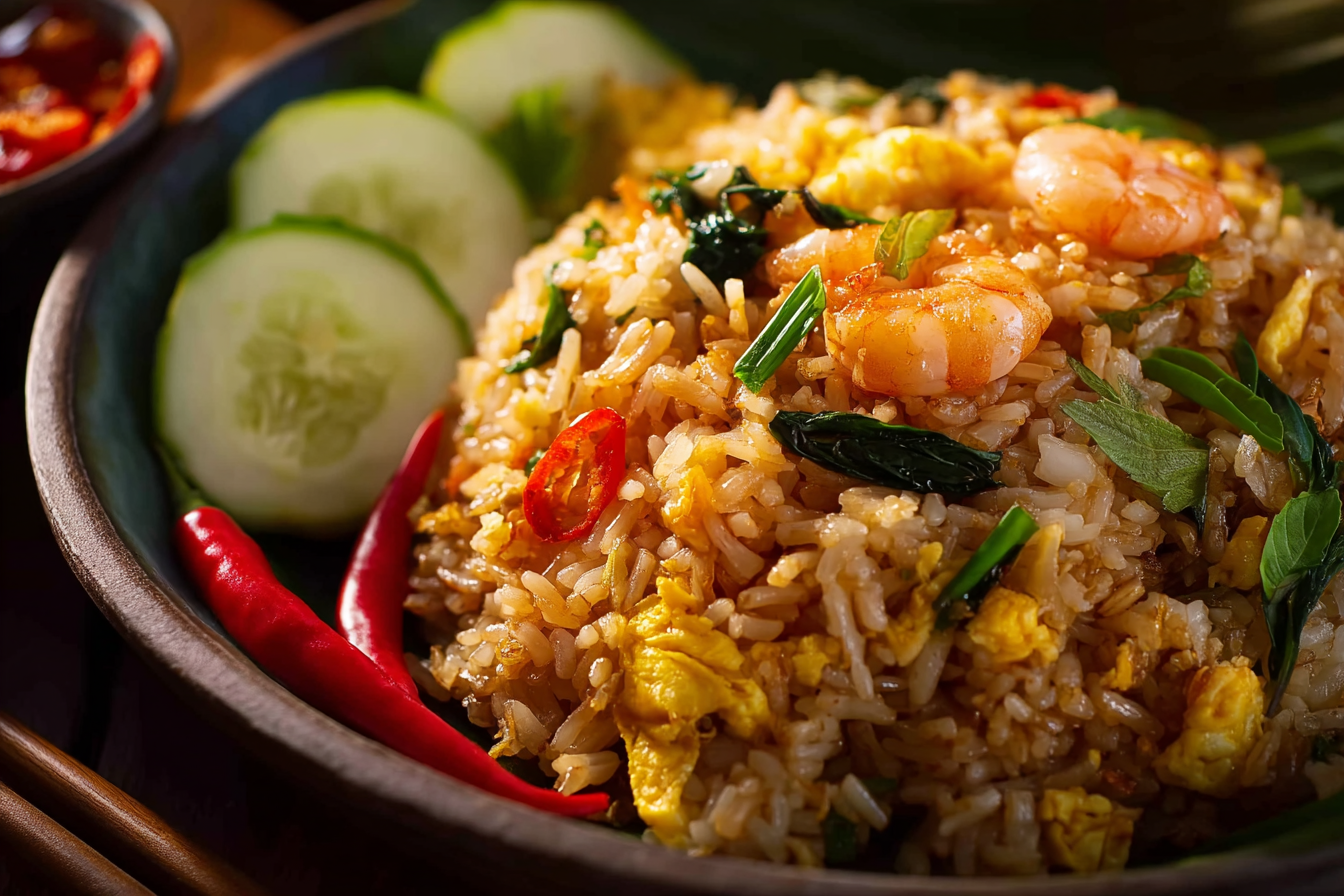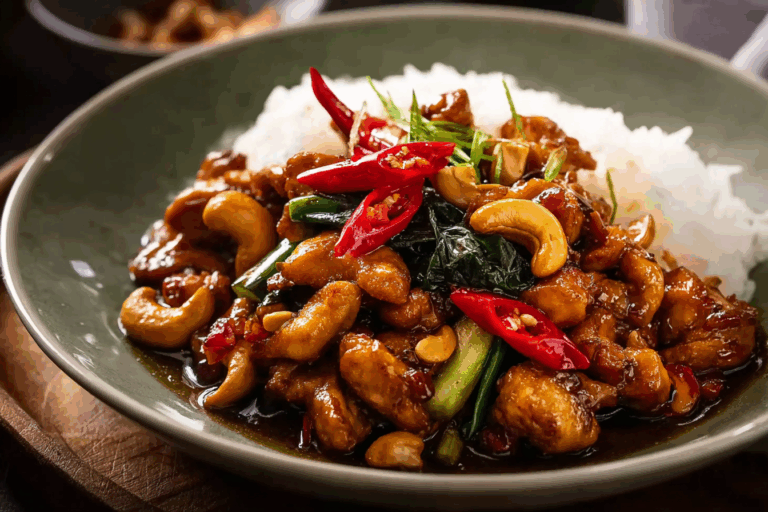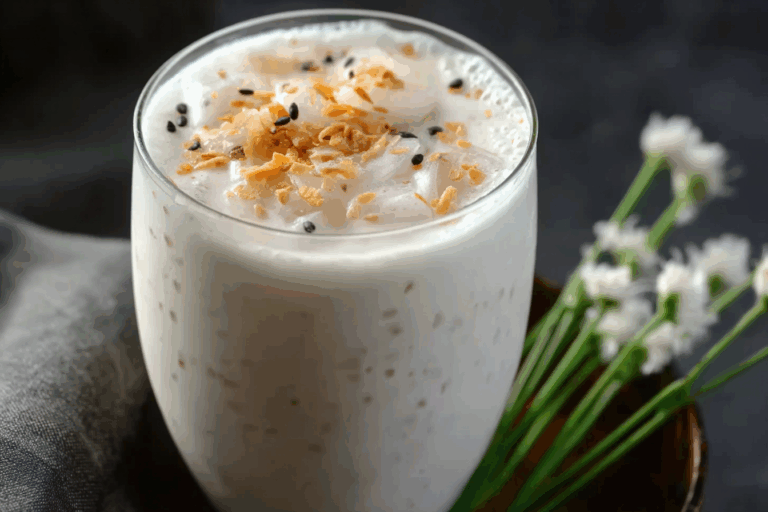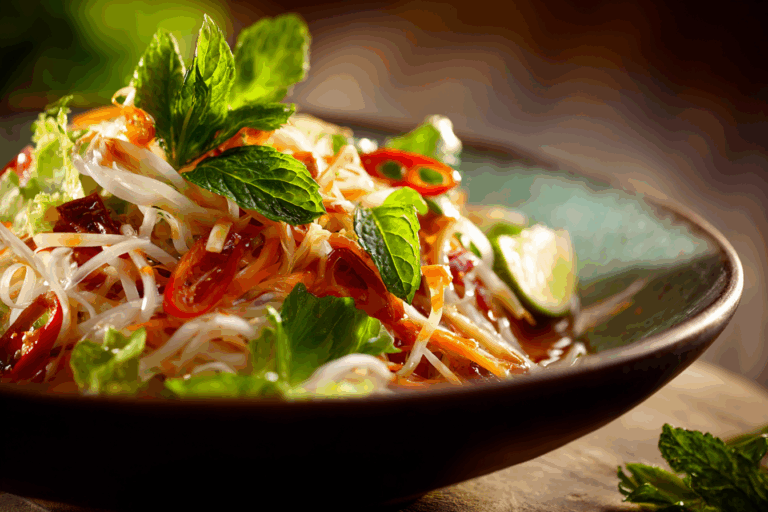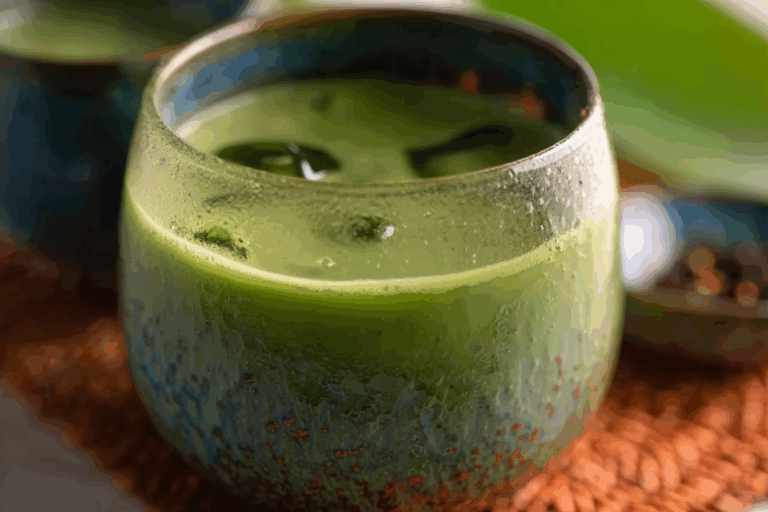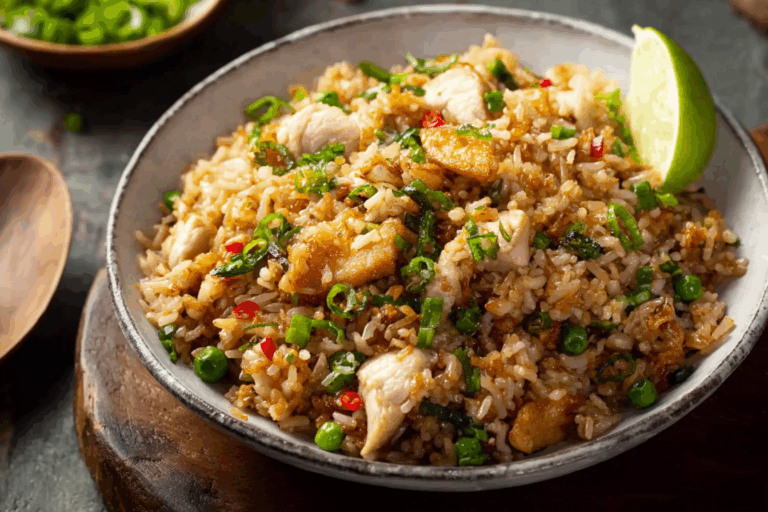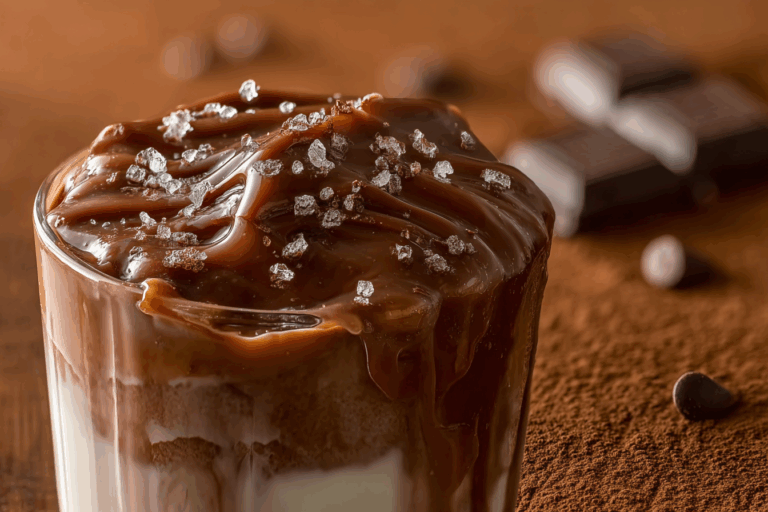Thai Basil Fried Rice Made Easy – Better Than Restaurants
Thai Basil Fried Rice is a dish that embodies the vibrant and aromatic essence of Thai cuisine. At JustThaiRecipes, our journey started with a deep love for these bold flavors. I’m Lina, the creator behind this blog, and together with my partner, we began this site to share the incredible dishes that shaped our childhood and travels across Thailand. Our About page tells the story of how our passion turned into a mission: bringing authentic Thai recipes to home cooks everywhere.
This journey led us to explore dishes like Thai Basil Fried Rice—a harmonious blend of jasmine rice, fresh Thai basil, succulent shrimp, and a medley of savory sauces. It’s a quick stir-fry that delivers a burst of sweet, spicy, and herbaceous notes in every bite. In this article, we’ll dive into what makes this dish unique, how to cook it perfectly at home, and why it stands out from other fried rice varieties. Looking for inspiration? Try our Thai Pineapple Fried Rice for another delicious variation.
Table of Contents
Table of Contents
What Is Thai Basil Fried Rice? Understanding Its Uniqueness
The Origins of Thai Basil Fried Rice
Thai Basil Fried Rice, known in Thai as Khao Pad Krapow, is a street food favorite across Thailand. Unlike standard fried rice, this dish pairs aromatic Thai basil with jasmine rice, creating a balance between spicy, sweet, and umami flavors. Traditionally, it’s cooked quickly over intense heat in a wok, making it a staple in busy Thai markets and home kitchens alike.
This dish is deeply rooted in Thai culinary tradition, showcasing the importance of fresh herbs and fast cooking techniques. Whether served in a small roadside stall or a high-end restaurant, its vibrant flavor profile remains the same: bold, comforting, and unforgettable.
The Flavor Profile That Sets It Apart
What makes Thai Fried Rice so irresistible? It’s all about layers of flavor. The sweetness of sugar, the saltiness of soy and oyster sauces, the gentle heat of Thai chilies, and the fragrant punch of Thai basil work together seamlessly. This combination delivers a complexity that’s both light and satisfying.
Unlike other fried rice dishes, the emphasis here isn’t just on the rice—it’s on how the herbs and sauces infuse the grains, making every spoonful exciting. Discover great ideas like our Berry Green Tea Smoothie to pair with this spicy dish for a refreshing contrast.
Print
Thai Basil Fried Rice
- Prep Time: 10 minutes
- Cook Time: 15 minutes
- Total Time: 25 minutes
- Yield: 4 servings 1x
- Category: Main Course
- Method: Stir-Fry
- Cuisine: Thai
- Diet: Gluten Free
Description
A flavorful Thai Basil Fried Rice packed with tender shrimp, aromatic herbs, and a perfect balance of savory, sweet, and spicy notes. Quick, easy, and perfect for a weeknight dinner.
Ingredients
- 3 cups cooked and cooled white rice
- 2 tablespoons vegetable oil (or olive, avocado, or peanut oil)
- ⅓ pound large prawns or shrimp (about 12-15)
- 1 shallot (or ½ onion), diced
- 2 green onions (scallions), thinly sliced
- 2 garlic cloves, minced
- 1–2 Thai chili peppers (optional)
- 2 eggs, lightly beaten
- 1½ tablespoons soy sauce
- 1½ tablespoons oyster sauce
- ½ teaspoon salt
- ½ teaspoon pepper
- 1 teaspoon sugar
- 1 tablespoon sesame oil
- 2–3 sprigs Thai basil
- To serve: tomato wedges, cucumber slices, lime wedges
Instructions
- Heat oil in a large skillet or wok over medium-high heat. Add shrimp and cook for 1–2 minutes on each side until fully cooked. Remove and set aside.
- Add a little more oil if needed, then stir in shallots, white part of green onions, garlic, and Thai chili. Cook until fragrant, about 1–2 minutes.
- Push aromatics to one side of the pan. Pour in the beaten eggs and scramble just until set. Mix with aromatics.
- Stir in the cooked rice along with soy sauce, oyster sauce, salt, pepper, sugar, and sesame oil. Stir-fry until everything is evenly coated and heated through.
- Return shrimp to the pan and stir in Thai basil. Let the bottom crisp for 1–2 minutes if desired, then stir again.
- Transfer to a serving dish and garnish with extra basil, green onions, and a squeeze of lime. Serve hot with tomato and cucumber slices.
Notes
- Use day-old rice for the best texture.
- Adjust chili peppers to your spice preference.
- Substitute chicken, tofu, or beef for shrimp if desired.
- Add extra vegetables like bell peppers or carrots for variety.
Nutrition
- Serving Size: 1 plate
- Calories: 420
- Sugar: 2g
- Sodium: 780mg
- Fat: 14g
- Saturated Fat: 2g
- Unsaturated Fat: 10g
- Trans Fat: 0g
- Carbohydrates: 52g
- Fiber: 2g
- Protein: 20g
- Cholesterol: 180mg
Keywords: Thai Basil Fried Rice, Shrimp Fried Rice, Thai stir fry, easy Thai rice recipe
Thai Basil Rice Ingredients and Substitutions
Essential Ingredients You’ll Need for Authentic Thai Basil Fried Rice
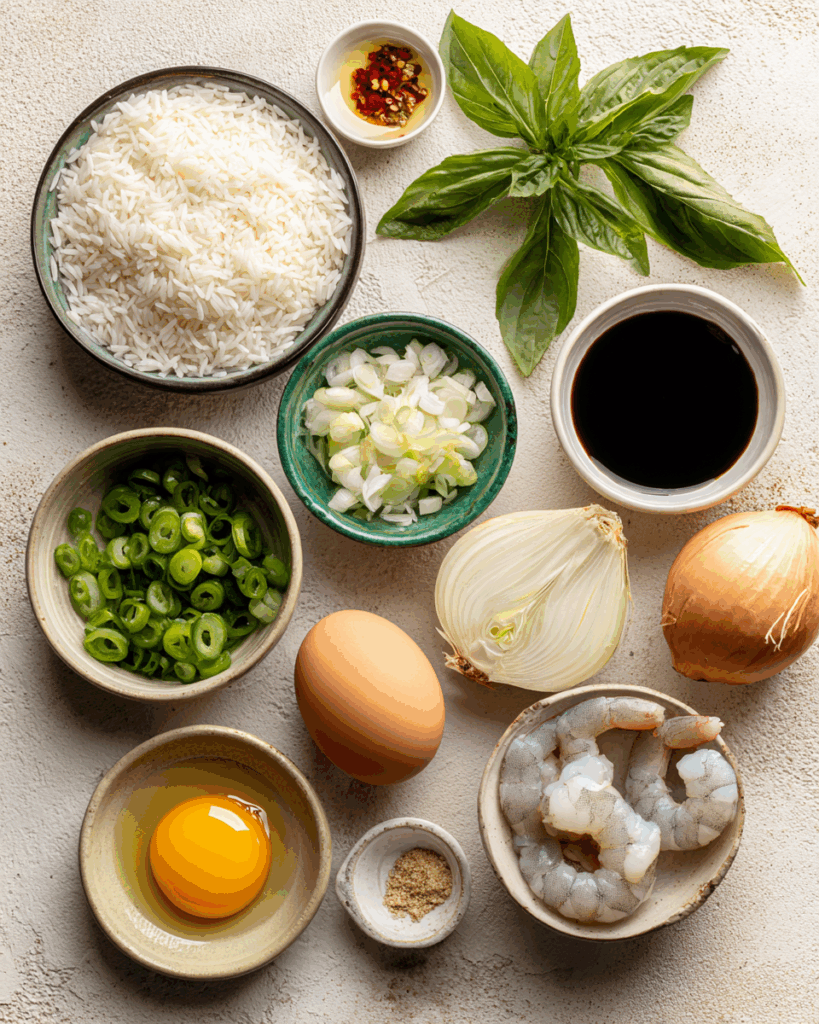
Creating Thai Basil Fried Rice at home is simple, but the secret lies in using the right ingredients. Here’s what you’ll need to achieve authentic flavors:
- 3 cups cooked and cooled white rice (preferably jasmine rice for its fragrant aroma and slightly sticky texture)
- 2 tablespoons vegetable oil (alternatively olive oil, avocado oil, or peanut oil for a richer depth)
- ⅓ pound large prawn or shrimp (approximately 12-15 pieces, cleaned and deveined)
- 1 shallot (or ½ onion), diced
- 2 green onions (scallions), thinly sliced
- 2 garlic cloves, minced
- 1-2 Thai chili peppers (optional for heat lovers)
- 2 eggs, lightly beaten
- 1½ tablespoon soy sauce
- 1½ tablespoon oyster sauce
- ½ teaspoon salt
- ½ teaspoon pepper
- 1 teaspoon sugar (to balance the savory elements)
- 1 tablespoon sesame oil (for a nutty finish)
- 2-3 sprigs of fresh Thai basil (the star of the dish for its peppery-sweet aroma)
Ingredient Substitutions for Every Kitchen
No Thai basil on hand? Use holy basil or sweet basil as alternatives, though the flavor will slightly differ. For a vegetarian Thai basil fried rice recipe, replace shrimp with tofu and swap oyster sauce for mushroom sauce. Gluten-free? Tamari or coconut aminos are perfect substitutes for soy sauce.
These substitutions let you enjoy a Thai basil fried rice recipe authentic to your dietary needs without sacrificing the essence of the dish.
Step-by-Step Guide to Cooking Authentic Thai Fried Rice
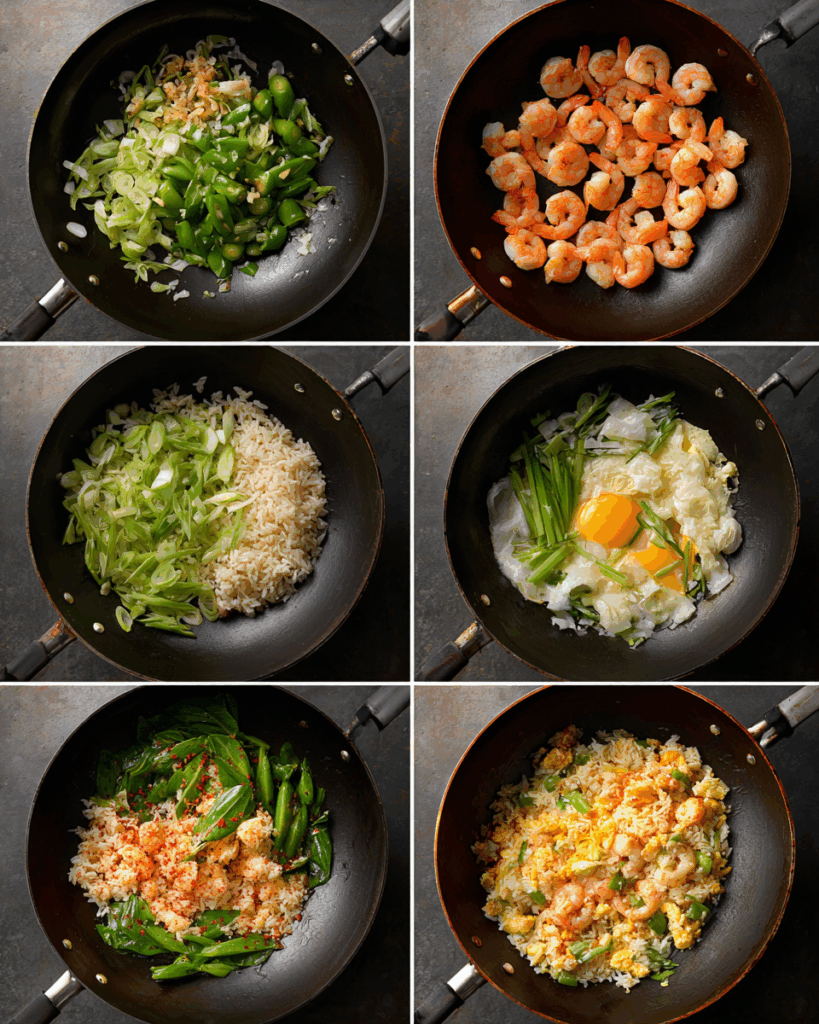
Prepping Your Ingredients for Success
Preparation is key. Always start with day-old rice. Freshly cooked rice tends to clump and turn mushy when stir-fried. Dice your aromatics, slice the chilies, and have your sauces measured and ready. This is critical because the cooking process moves fast.
Cooking Instructions for Perfect Thai Fried Rice
- Cook the Shrimp: Heat oil in a large skillet or wok over medium-high heat. Add shrimp and cook for 1–2 minutes on each side until pink and fully cooked. Remove and set aside.
- Sauté Aromatics: Add a touch more oil if needed. Stir in shallots, garlic, Thai chili peppers, and the white part of the green onions. Cook for 1–2 minutes until fragrant.
- Add the Eggs: Push aromatics to one side of the pan. Pour in beaten eggs and scramble lightly until just set, then mix them with the aromatics.
- Combine Rice and Seasonings: Stir in the cooled jasmine rice. Add soy sauce, oyster sauce, sesame oil, sugar, salt, and pepper. Stir-fry quickly, ensuring each grain of rice is coated in the seasoning.
- Finish With Basil and Shrimp: Return shrimp to the pan. Add Thai basil leaves, tossing everything together until the basil is wilted and the rice is slightly crisped at the bottom.
- Serve Immediately: Garnish with lime wedges, fresh basil, sliced cucumbers, and tomato wedges for a traditional Thai presentation.
This step-by-step process helps you achieve the smoky, restaurant-quality flavor known as wok hei, making your homemade Thai basil fried rice restaurant-worthy. Don’t miss our Thai Mango Sticky Rice for dessert—it’s a perfect pairing.
Why Thai Fried Rice Tastes Different
Unique Ingredients That Set Thai Basil Fried Rice Apart
The distinctive flavor of Thai Basil Fried Rice comes from its signature ingredients. Jasmine rice provides a light and aromatic base, while Thai basil infuses a peppery, slightly sweet essence that’s unmatched. Additions like fish sauce, oyster sauce, and Thai chilies create the bold umami and heat Thai cuisine is known for.
Unlike Chinese fried rice, which often uses neutral oils and soy sauce as its primary flavoring, Thai fried rice leans heavily on herbs and layered seasonings. Thai basil, in particular, is a game-changer. It not only lifts the aroma but also balances the sweet and spicy components perfectly.
For another variation that’s bursting with spicy flavors, check out this 3-Chili Fried Rice recipe from Hot Thai Kitchen. It’s a fiery twist on the classic fried rice, ideal for spice lovers.
Cooking Techniques That Create Bold Flavors
In Thailand, chefs often use high heat and large woks to achieve the sought-after wok hei—that smoky, slightly charred flavor that clings to the rice. Stir-frying quickly ensures that the rice grains stay separate and the vegetables retain their crunch.
This technique, combined with fragrant oils like peanut or sesame oil, gives Thai fried rice a more robust taste profile compared to its milder counterparts.
Nutritional Profile and Health Benefits
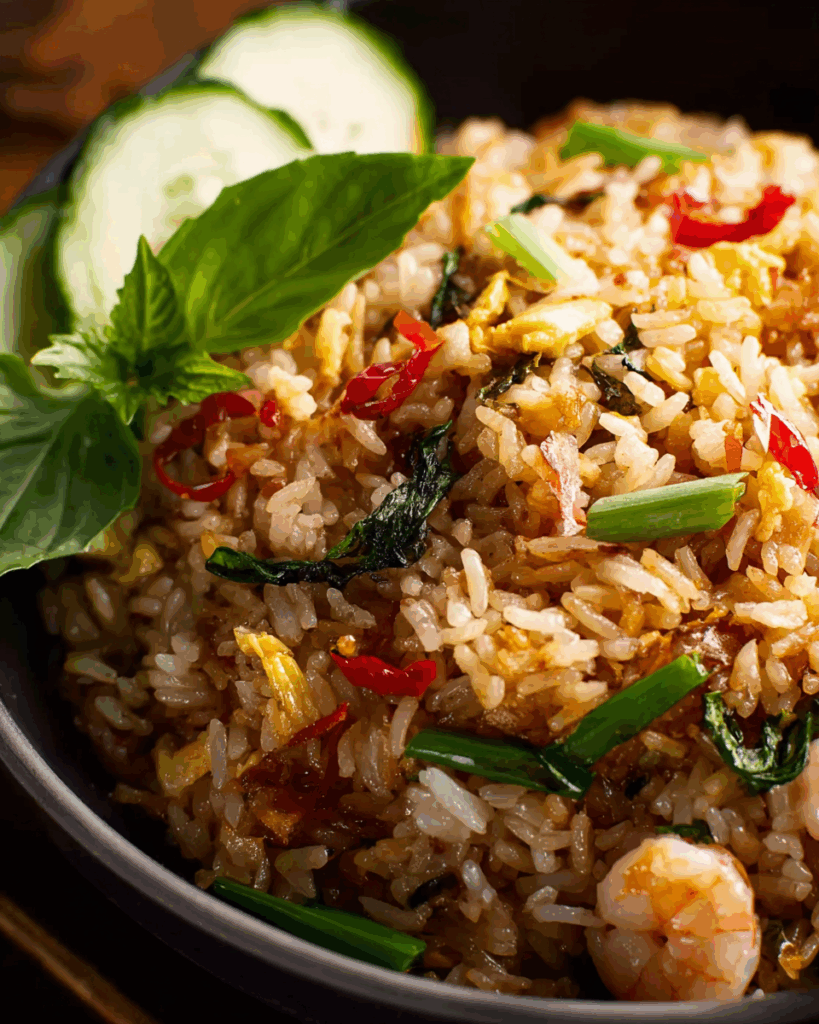
Thai Basil Rice Calories and Macronutrients
A standard serving of Thai Basil Fried Rice with shrimp provides approximately:
| Nutrient | Amount per Serving |
|---|---|
| Calories | 450 kcal |
| Protein | 25 g |
| Carbohydrates | 55 g |
| Fats | 15 g |
| Fiber | 3 g |
This makes it a balanced dish—high in protein from shrimp, moderate in healthy fats from sesame oil, and rich in complex carbs from jasmine rice.
Is Thai Basil Fried Rice Healthy?
When made at home, it can be a wholesome choice. Using minimal oil and adding more vegetables like bell peppers or baby corn enhances its nutritional value. Thai basil is rich in antioxidants and has anti-inflammatory properties.
For a lighter version, consider swapping white rice with cauliflower rice or quinoa. For inspiration on healthier Thai recipes, visit Little Spice Jar’s Thai Basil Fried Rice which offers practical tips for tweaking this dish to fit your diet.
Additionally, if you love chicken, try this Thai Spicy Basil Chicken Fried Rice from AllRecipes. It’s another great variation for a high-protein meal.
Popular Variations of Thai Basil Fried Rice
Classic Thai Basil Fried Rice Recipe
This version uses large prawns or shrimp, Thai jasmine rice, and authentic Thai basil leaves. The balance of sweet, salty, and spicy flavors stays true to traditional street food in Bangkok. It’s a favorite for its vibrant taste and quick preparation.
Vegetarian Thai Basil Fried Rice Recipe
For those avoiding meat, this vegetarian Thai basil fried rice recipe is a wonderful alternative. Replace shrimp with cubed firm tofu or seared tempeh for added protein. Use vegetarian oyster sauce or mushroom sauce to maintain the umami flavor. This variation retains the bold flavors but makes it suitable for plant-based diets.
Thai Basil Fried Rice Near Me: How Local Versions Differ
When ordering Thai basil fried rice at a restaurant near you, expect slight adaptations. Some places use sweet basil instead of Thai basil due to availability. Others may add vegetables like bell peppers, broccoli, or zucchini to cater to Western palates. In Thailand, however, the recipe is typically simpler and focuses on the key aromatics.
Thai Basil Fried Rice Recipe Authentic Version
The authentic Thai basil fried rice recipe emphasizes a minimalist ingredient list: jasmine rice, Thai basil, fish sauce, soy sauce, garlic, chilies, and your protein of choice (commonly shrimp, chicken, or pork). It’s cooked fast over high heat for a light yet bold dish. No ketchup, no carrots—just pure Thai street food magic.
Thai Basil Fried Rice Ingredients Overview
Each ingredient plays a key role:
- Jasmine rice: Aromatic and slightly sticky, perfect for stir-frying.
- Thai basil: Peppery and sweet with a unique anise-like aroma.
- Soy & oyster sauces: The salty-sweet umami backbone.
- Chilies: Optional but recommended for a kick.
- Shrimp or chicken: Tender protein that absorbs the flavors beautifully.
Serving Suggestions and Pairings
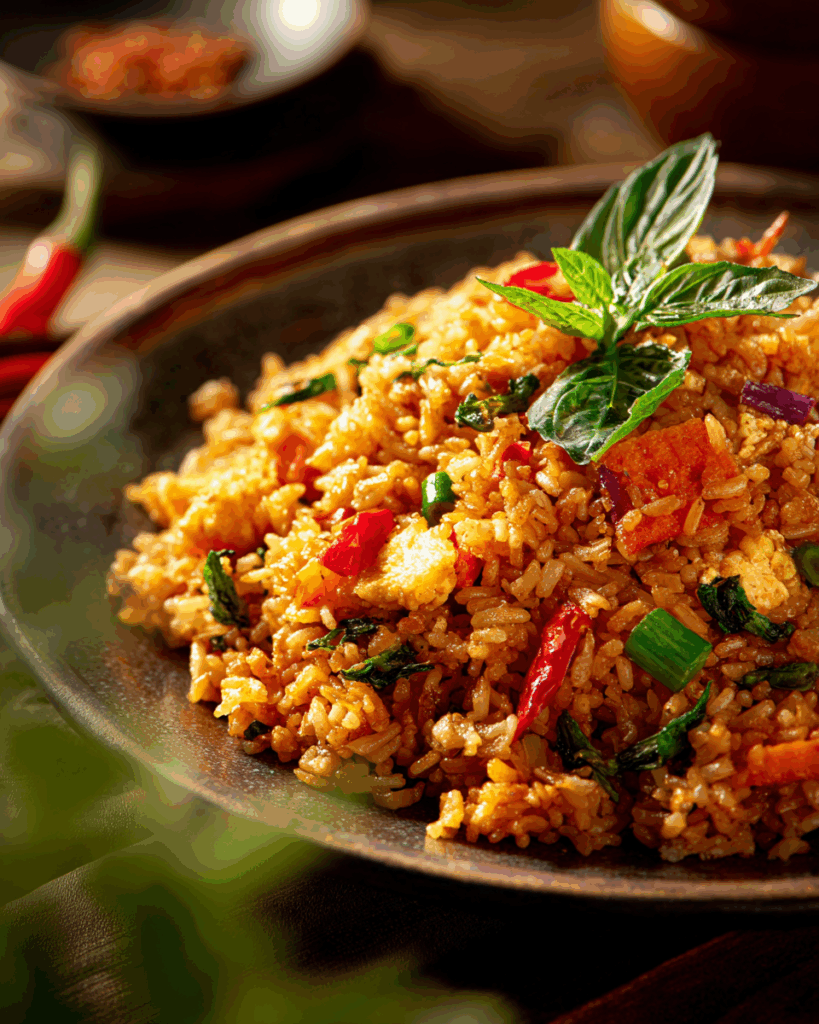
Traditional Thai Accompaniments
Thai basil fried rice is often served with:
- Wedges of lime to add a refreshing citrusy brightness.
- Slices of cucumber and tomato for cooling contrast to the heat.
- A small side of Nam Pla Prik (fish sauce with sliced chilies and lime juice) to boost the flavors further.
Creative Pairings for a Full Meal
Pair Thai basil fried rice with:
- A light Thai mango salad for added crunch and sweetness.
- Tom Yum soup for a spicy-sour counterbalance.
- Thai iced tea or iced green tea for a cooling beverage.
Thai Basil Fried Rice Calories and Portion Sizes
A typical serving (1½ cups) contains around 450–500 calories, depending on the oil and protein used. Homemade versions tend to have fewer calories since you control oil quantities. Adding more vegetables increases fiber content, making it more filling without drastically increasing calories.
The Cultural Significance of Thai Basil Fried Rice
Thai Basil Fried Rice in Thai Cuisine
In Thailand, fried rice isn’t just a side dish—it’s often a meal on its own. Thai basil fried rice, or Khao Pad Krapow, is beloved because it represents the harmony of Thai cooking: sweet, salty, sour, and spicy in perfect balance.
It’s a popular lunch and dinner option in Thai households and street food stalls. Vendors prepare it lightning-fast in woks over open flames, serving it with fried egg (Khai Dao) for an extra indulgence.
A Dish for Every Occasion
Whether enjoyed as a quick street food meal or served at family gatherings, Thai basil fried rice reflects Thai people’s love for fresh, aromatic ingredients and bold flavors. The simplicity of its preparation also makes it a go-to recipe for home cooks pressed for time.
Tips for Making Thai Basil Fried Rice Like a Pro
Start With Day-Old Rice
Day-old rice is drier and less likely to clump, which is essential for achieving the perfect fried rice texture. If using freshly cooked rice, spread it on a tray and cool it completely before stir-frying.
Cook Over High Heat
A searing hot pan or wok ensures quick cooking and creates that lightly smoky flavor Thai chefs call wok hei.
Add Basil at the End
To preserve its vibrant color and aroma, stir in Thai basil only during the final minute of cooking. Overcooking will dull the herb’s fresh, peppery taste.
Balance the Flavors
Taste your fried rice before serving. Add a splash of lime juice for brightness or a pinch of sugar to round out the savory flavors if needed.
Creative Ways to Customize Thai Basil Fried Rice
Add More Vegetables
Boost the nutritional value by adding bell peppers, baby corn, snow peas, or carrots. These bring color, crunch, and extra vitamins.
Change the Protein
While shrimp is traditional, you can use chicken, beef, pork, or even firm tofu for a vegetarian option. Sliced mushrooms also make a great meat substitute.
Spice Levels to Suit Your Taste
Adjust the number of Thai chilies to control heat. For a milder dish, remove seeds from the chilies or substitute with milder peppers.
Make It a Fusion Dish
For a creative twist, top your fried rice with a runny fried egg (Khai Dao) or drizzle with Sriracha or sweet chili sauce for a fusion of Thai and Western flavors.
Common Mistakes to Avoid When Making Thai Basil Fried Rice
Using Freshly Cooked Rice
Freshly steamed rice tends to be too moist and sticky, leading to clumps when stir-fried. Always use day-old rice that’s been chilled. If you’re short on time, spread freshly cooked rice on a baking sheet and refrigerate it for 30 minutes.
Overcooking the Basil Leaves
Thai basil is delicate and should only be added at the very end of cooking. Prolonged heat will cause it to lose its vibrant flavor and turn dark in color.
Not Prepping Ingredients in Advance
Thai Basil Fried Rice comes together in minutes. Without prepping your ingredients, you risk burning components or overcooking parts of the dish while scrambling to chop or measure.
Using the Wrong Oil
Neutral oils like vegetable, peanut, or avocado oil handle high heat better than olive oil. Using oils with low smoke points can make the dish taste burnt.
Skipping High Heat
Cooking on low heat results in soggy rice. High heat is crucial for achieving the slightly crispy texture and smoky wok hei flavor.
Conclusion
Thai Basil Fried Rice isn’t just a dish; it’s an experience that delivers the essence of Thai street food straight to your kitchen. Its fragrant jasmine rice, spicy chilies, and the fresh aroma of Thai basil make it one of the most delicious Thai dishes to try at home. Whether you’re craving a quick weeknight dinner or looking to impress guests, this recipe is versatile and deeply satisfying. For a perfect finish to your Thai meal, don’t miss our Thai Mango Sticky Rice recipe, which complements the spicy flavors with a sweet, creamy dessert.
FAQs About Thai Basil Fried Rice
Does basil go well with rice?
Absolutely. Thai basil’s peppery-sweet and slightly anise-like flavor complements the mildness of rice, creating a dish that’s both aromatic and flavorful.
How is Thai fried rice different from Chinese fried rice?
While Chinese fried rice often features soy sauce, green onions, and neutral flavors, Thai fried rice introduces herbs like Thai basil and chilies for a more vibrant and spicy flavor profile. Jasmine rice also gives it a softer texture and fragrant aroma.
What makes Thai fried rice taste different?
Thai fried rice stands out for its use of jasmine rice, Thai basil, fish sauce, and oyster sauce. These ingredients create a unique aromatic profile, while cooking over high heat adds a slight smokiness.
What is Thai basil fried rice?
Thai basil fried rice is a fragrant stir-fried rice dish made with jasmine rice, Thai basil, soy sauce, oyster sauce, chilies, garlic, and a choice of protein such as shrimp or chicken. It’s known for its balance of sweet, spicy, and herbaceous flavors.

